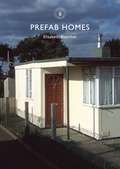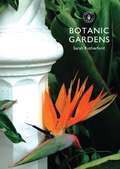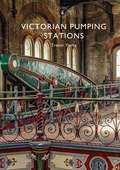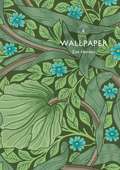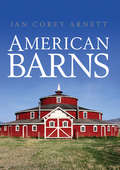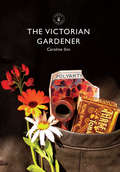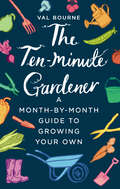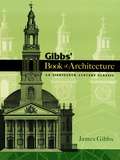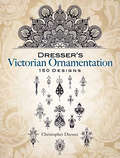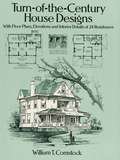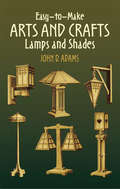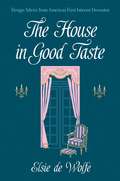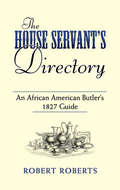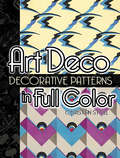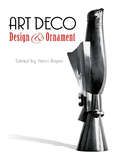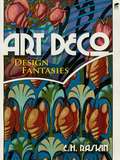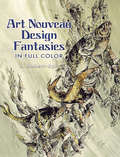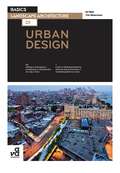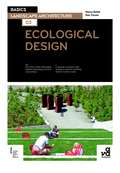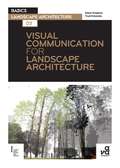- Table View
- List View
Prefab Homes (Shire Library #788)
by Elisabeth BlanchetAt the end of the Second World War Winston Churchill promised to manufacture half a million prefabricated bungalows to ease the housing shortage; in the end more than 156,000 temporary 'prefabs' were delivered. Nicknamed 'Palaces for the People', and with convenient kitchens, bathrooms and heating systems, they proved popular and instead of being demolished as intended they were defended by residents who campaigned to keep their family homes and communities. Nearly seventy years later, as the last of these two bedroom homes are being demolished, Elisabeth Blanchet tells the story of these popular dwellings and their gardens and shows the various designs that were produced. Through the stories and memories of residents, she also reveals the communities who were pleased to live in the prefabs.
Botanic Gardens (Shire Library)
by Sarah RutherfordAcross the world hundreds of botanic gardens combine scientific research, conservation and beauty with public access, with Kew Gardens alone attracting around one million visitors a year. For centuries they have variously focused on cultivating medicinal and exotic plants, introducing lucrative crops such as tea and rubber to new countries, preserving international plant collections, scientific classification and research – or have combined all these things. Sarah Rutherford here tells their story from the sixteenth-century up to their long heyday in the last two hundred years. She explains the gardens' design and architecture, the personalities and institutions associated with them, their important role in research and conservation, and their appeal to millions of visitors.
Victorian Pumping Stations (Shire Library #846)
by Trevor YorkeVictorian pumping stations are colourful cathedrals of utility. Their imposing and striking exteriors enclose highly decorative cast-iron frames, built to encage powerful steam engines. They are glorious buildings which display the Victorians' architectural confidence and engineering skills. More than that, they represent a key part of the story of urban development and how our towns and cities were shaped in this period of ground-breaking invention and civic pride. In this illustrated guide, Trevor Yorke tells the story of Victorian pumping stations and explains why they were built in such a flamboyant manner, describing their architectural features and showing how their mighty steam engines worked. He includes examples of their glorious interior decoration from pumping stations across the country and provides a detailed list of those which are open to visitors.
Wallpaper (Shire Library)
by Zoë HendonWe agonise and argue when choosing it; we admire, compliment and criticise it (or keep politely quiet about it); and the rest of the time we don't even notice it. Wallpaper has been the backdrop to our homes for hundreds of years. It can make a house feel cosy or trendy, modern or traditional, and it is one of the key elements of home décor through which to express personal taste. Despite the threat from plain-painted minimalism, wallpaper maintains a strong presence in modern domestic decoration. Zoë Hendon traces the history of wallpaper in Britain and its foremost designers, examining how social mobility and new technologies have influenced design trends. From early Chinoiserie, through William Morris and on to the 'feature wall', this book looks at wallpaper's surprisingly controversial place in shaping our sense of home.
American Barns (Shire Library Usa Ser. #751)
by Jan Corey ArnettThe heart of every working farm and ranch, the barn is an icon of rural America. This book chronicles – and celebrates – all the main types, and looks at how these treasures of early American architecture developed. It explains how a wealth of immigrant construction methods and range of environments and climates resulted in a fascinating variety of barn styles in the United States, from the earliest rare Dutch examples to simpler English types and others in more surprising shapes (round or even polygonal) crafted by the Shakers in the 1800s. It highlights the most notable, famous and historic barns that the reader can visit, and features the efforts of conservation groups to preserve America's barns and find innovative ways to repurpose these glorious old structures as homes and studios – and as living monuments of rural heritage.
The Victorian Gardener (Shire Library #780)
by Caroline IkinOver the course of the nineteenth century, gardening came to be considered a respectable profession, providing a means to an education, a good chance of advancement and decent working conditions. The hierarchy of the garden staff became just as regimented as that of domestic servants, and progression was attained by hard work, self-improvement and ambition. Training courses and apprenticeships prepared young gardeners for their trade and horticulture became recognised as a skilled profession, with the head gardener commanding a position of influence and respect and women overcoming social barriers to join their peers on equal terms. This book explores the gardening profession within the complexities of Victorian society and the advances in science and technology that pushed the gardener further into the limelight.
London’s Royal Parks (Shire Library #793)
by Paul RabbittsLondon's royal parks are amongst its most beautiful and beloved spaces: just as much as the Houses of Parliament, Buckingham Palace and Victoria Station, the mere mention of Hyde or Regent's Park is enough to evoke the capital in all its glory for residents and tourists alike. They have a grand history – some having been royally-owned as far back as the Norman conquest, and others having been acquired by Henry VIII during the Reformation – and since being opened to the public during the eighteenth century have hosted some of London's great events, including the Great Exhibition and innumerable jubilees and celebrations. This book tells the story of all nine of the parks from the point when they were acquired by the monarchy until the present day, including the major historic moments and events with which they are associated.
Icehouses (Shire Library)
by Tim BuxbaumOften hidden away or incorporated into other architectural features, icehouses are a largely forgotten part of our heritage. As winters warmed through the nineteenth century, and supplies of natural ice declined, the development of artificial refrigeration made redundant these curious buildings – often status symbols in themselves – which had been designed to store winter snow and ice into the summer. Icehouses allowed perishables to be preserved, chilled delicacies to be enjoyed, and fevers to be relieved – and on a commercial scale they fed an international trade that carried snow from mountain peaks and ice from frozen lakes to supply the needs of industry, markets and householders. In this illustrated introduction, Tim Buxbaum explains how icehouses developed; how, when and where they were built; and how they operated, including a chapter on icehouses from around the world.
Humphry Repton (Shire Library)
by Laura MayerHumphry Repton (1752–1818) ambitiously styled himself Capability Brown's successor: the century's next great improver of landed property. With his rare combinations of skills – he was a talented topographical sketcher with an excellent knowledge of farming – over thirty years Repton amassed an incredible four hundred commissions, ingratiating himself with the aristocracy and raising the status of his adopted profession. His famous Red Books, illustrated to help clients visualize the potential of their estates, also did their part to encourage the appreciation of landscape aesthetics. With colourful illustrations and detailed site investigations, this book traces Repton's landscape designs from Picturesque wildernesses like Blaise Castle to the progressive Gardenesque style of Wanstead House in Greater London. It is both a perfect visitor's guide to the gardens and an introduction to the theory of Repton's work.
Global Corporate Workplaces: Implementing New Global Workplace Standards in a Local Context
by Martin HodulakThis book is about the currently evolving global standardization of corporate workplace models and the challenges this poses for their implementation in a local context. In recent years, multinational corporations were increasingly engaged in the development of standardized global workplace models. For their implementation and feasibility, it is decisive as how these standards fit the diverse regional workplace cultures. This topic was pursued in the course of a research project, comparing established workplaces in Germany, USA and Japan against global workplace standards of multinational corporations.The analysis confirmed the expected differences among local workplaces and on the other hand a predominant mainstream among global corporate workplace standards. Conspicuous however, are the fundamental differences between local models and corporate standards. For the implementation of global standards in local context, this implies multiple challenges on cultural, organizational and spatial level. The analysis findings provide information for assessing current projects and pinpointing optimization measures. The analysis framework further provides a tool to uncover and assess needs and restrictions for the development of future workplace models.
The Ten-Minute Gardener: A month-by-month guide to growing your own (Ten-minute Gardener Ser.)
by Val BourneTHE PERFECT GIFT FOR GARDENERSWhether you have a spacious plot or a small patch in the garden, this handbook is full of tried-and-tested tips from a seasoned old hand. It offers practical month-by-month suggestions for making the most of the little time you can spare on both the coldest winter days and the long summer afternoons, with ideas to inspire even the most experienced allotment gardeners. Focusing on the essentials needed to produce a great crop, this is for those who want to but struggle to find the time to grow their own.For those who garden in snatched moments . . . *Combined and updated editions of The Ten Minute Gardener's Fruit-Growing Diary and The Ten Minute Gardener's Vegetable-Growing Diary*
Gibbs' Book of Architecture: An Eighteenth-Century Classic
by James GibbsOne of England's most respected and influential architects, James Gibbs was born in Scotland, studied in Rome, and left a legacy of design the world will treasure forever. His legendary 1728 folio, a sprawling gallery of Gibbs's magnificent drawings, perspectives, and blueprints, is a brilliant testimony to his remarkable talent. Profusely illustrated, the volume features such notable commissions as London's St. Martin in the Fields -- the inspiration for many steeple churches of the colonial period in America; St. Mary le Strand, his first public building; Marybone Chapel; The Church of Allhallows in Derby; plus Gibbs's first commission, an addition for King's College at Cambridge. His most outstanding accomplishment may be the circular Radcliffe Library at Oxford, for which he received a Master of Arts. Also included here are detailed floor plans, plus fine drawings of decorative marble cisterns, ornamental iron gates, stately funeral monuments, and much more. Essential for an understanding of classic architecture, this stunning edition should grace the bookshelf of every architect, as well as architectural students, teachers, and historians.
Dresser's Victorian Ornamentation
by Christopher DresserBorders in the style of medieval manuscripts, patterns based on Greek and Persian pottery, designs adapted from Venetian lace--this unique sourcebook abounds in splendid original ornaments. Its gorgeous black-and-white drawings include such diverse influences as German Gothic, Japanese, Arabic, Indian, Celtic, and ancient Roman art.A pioneer of modern design, Christopher Dresser (1834-1904) was one of the Victorian era's most important and influential stylists, whose works are eagerly sought by artists and craftspeople. A botanist by training, Dresser was particularly skilled in the execution of floral motifs. This versatile collection of his designs can be easily adapted to art and craft projects, textiles, interior decoration, wall hangings, lacework, carvings, and much more.
Turn-of-the-Century House Designs: With Floor Plans, Elevations and Interior Details of 24 Residences
by William T. ComstockThis inexpensive archive of handsome turn-of-the-century designs reprinted directly from a rare late Victorian volume contains plans for a variety of suburban and country homes that are both aesthetically appealing and moderate in cost. Included are plans for 24 cottages and houses in a wide range of styles, among them Queen Anne, Eastlake, and Colonial. Over 130 illustrations — floor plans, elevations, perspective views, and more — enhance the text, which is further supplemented by two informative and useful articles: "Suggestions on House Building," by A. W. Cobb, describes the process of building a home, from the first sketches offered by the architect to his client, to property selection, scale drawings, and details of construction. “How to Plumb a Suburban House,” by Leonard D. Hosford, provided the late Victorian era homeowner with valuable advice about sewage disposal.Restorers of old houses, preservationists, and students of American architectural history will welcome this treasury of authentic century-old plans and details. Students of social history will also find it an excellent reference.
Easy-to-Make Arts and Crafts Lamps and Shades
by John D. AdamsFashionable in the early twentieth century, Arts and Crafts-style lamps are popular again in the twenty-first century. The elegant simplicity of these useful furnishings will inspire craftworkers to try their hand at the handsome projects described in this instructive manual.First published nearly a century ago, this step-by-step guide--with measurements for sixteen projects--shows how to turn simple, inexpensive materials into a wide range of beautiful and functional Arts and Crafts projects, among them portable table lamps, reading and piano lamps, a dining room dome, a lantern, a shade for a droplight, and wall-hanging lamps, as well as a newel post lamp, and an electric candle sconce.Antique collectors, historians of American style, and lovers of vintage furnishings will also find invaluable information in this collection of now-rare lighting fixtures.
The House in Good Taste: Design Advice from America's First Interior Decorator (Dover Architecture)
by Elsie De Wolfe"Good taste can be developed in anyone, just as surely as good manners are possible to anyone. And good taste is as necessary as good manners," declared Elsie de Wolfe, the "first lady" of American interior design. Although de Wolfe decorated the homes of wealthy, socially prominent clients, she always maintained that her vision of elegant but comfortable living is attainable to all. This timeless 1913 book, written in a friendly, conversational tone, explains how to design, furnish, and decorate a house in order to make it a beautiful, useful, and livable home.De Wolfe pioneered the concept of the home as a representation of the owner's identity, and this book defines her decorating methods, philosophy, and approach to creating spaces for gracious entertaining. Part step-by-step manual and part aesthetic treatise, this volume advocates for simpler yet more refined decor. In contrast to the Victorian penchant for dark furniture, bric-a-brac, and heavy draperies, de Wolfe advised her readers to let in natural light, to replace gaudy colors with beige and ivory, and to abandon clutter. Her practical suggestions, illustrated by period photographs, illuminate the attitudes of a century ago while retaining their resonance for modern-day interior designers.
The House Servant's Directory: An African American Butler's 1827 Guide (American Antiquarian Cookbook Collection)
by Robert Roberts"In order to get through your work in proper time, you should make it your chief study to rise early in the morning; for an hour before the family rises is worth more to you than two after they are up."So begins Robert Roberts' The House Servant's Directory, first published in 1827 and the standard for household management for decades afterward. A classic survey of work, home life, and race relations in early America, the book was the result of many years of Roberts' personal and professional experiences. One of the first books written by an African-American and published by a commercial press, this manual for butlers and waiters offers keen insight into the social milieu, hierarchy, and maintenance of the antebellum manor.As a servant to a prominent New England family, Roberts provided valuable insights into what was expected of domestic servants. His book contains an abundance of instructions for successfully completing household chores as well as suggestions for properly cleaning furniture and clothing; and for buying, preparing, and serving food and drink for dinner parties of all sizes (much of which is still useful information today). The text also contains suggestions for arranging servants' work routines, and advice to heads of families on how best to manage their domestic help -- extraordinary recommendations for master-servant relationships and highly unusual for the time.Among the most famous of etiquette books to provide instruction on proper behavior for domestic servants in the early nineteenth century, Roberts' Directory remains a critical primary source in sociology and African-American history.
Art Deco: Decorative Patterns in Full Color
by Christian StollDerived from various avant-garde painting styles of the early twentieth century, the Art Deco movement comprised a mix of Cubism, abstraction, distortion, and simplification. Geometric shapes and vibrant colors were popular elements of this sophisticated style of ornamentation that found expression in architecture and the applied arts.This collection of sensuous, bold and exotic motifs, reprinted from a rare 1910 portfolio, contains a wealth of arresting Art Deco wallpaper patterns. 160 striking, royalty-free designs--a must-have collection for designers and craftworkers--depict a breathtaking array of florals, geometrics, and abstract designs, all stunning in their presentation and elegant in their simplicity.
Art Deco Design and Ornament
by Henri RapinA major design movement of the 1920s and 1930s, Art Deco drew its strength from architecture, modern art, primitivism, and industry. It gave us the Chrysler Building and Soviet post art -- and also gave us a legacy that continues to pulse with energy and excitement even today.In this rich collection of 349 images, the Art Deco style is evident in every draping vine, languid curve, bulging muscle, and geometric figure. It will leap out at you from friezes, plaques, sculpture, vases, doorways, tiles, furniture, arches, and more.It's a splendid book for anyone interested in the arts -- and for artists and craftsmen, a genuine wellspring of artistic ideas.
Art Deco: Design Fantasies
by E. H. RaskinDerived from a rare French publication of the 1920s, Fantaisies Oceanographiques, these beguiling images pulse with the flowing grace of aquatic life. The 30 full-color plates feature 56 abstract and figurative patterns in authentic Art Deco style. Whether simply browsed for pleasure or as a source of ideas for design or decorative projects, these playful images of marine plants and animals offer a wealth of inspiration.
Art Nouveau Design Fantasies in Full Color
by J. Habert-DysElegant and distinctive, these eye-catching motifs combine a refined naturalism with the sophistication of Art Nouveau. Created during the early years of Art Nouveau, they reflect the late nineteenth century interest in Japanese art, as well as the fresh excitement of a blossoming movement that's remained fashionable for well over a century.Sixty-six full-color images feature luxurious patterns and ornaments designed for ceramics, furniture, textiles, walls, and ceilings. Superbly reproduced from a rare folio, these decorations were formerly available only in high-priced antiquarian editions. This inexpensive compilation makes them readily accessible and royalty-free to graphic artists, crafters, and designers.
The Fundamentals of Landscape Architecture (Fundamentals)
by Tim WatermanThe Fundamentals of Landscape Architecture provides an introduction to the key elements of this broad field. From climate change to sustainable communities, landscape architecture is at the forefront of today's most crucial issues. This book explains the process of designing for sites, calling upon historical precedent and evolving philosophies to discuss how a project moves from concept to realization. It serves as a guide to the many specializations within landscape architecture, such as landscape strategy and urban design.
Basics Landscape Architecture 01: Urban Design (Basics Landscape Architecture)
by Tim Waterman Ed WallBasics Landscape Architecture 01: Urban Design seeks to define and describe the role played by landscape architecture in urban design, an interdisciplinary practice that is concerned with defining the form of human settlements.It provides a brief history and definition of urban design and the roles of the various professions involved.Urban Design looks at the elements of urban form and the importance of contextual details, from the scale of the city and its region to the importance of materials.The text uses case studies to explore the philosophies and methodologies of urban design and to explain the importance of of urban design to landscape architecture and, in turn, the importance of landscape architecture to urban design.
Basics Landscape Architecture 02: Ecological Design (Basics Landscape Architecture)
by Nancy Rottle Ken YocomBasics Landscape Architecture 02: Ecological Design provides an overview of ecological design and planning for landscape architects. It explores the concepts and themes important to the contemporary practice of ecological design and planning in a highly accessible and richly illustrated format. Focusing primarily on urban environments, this book examines the relationships between ecological design theory and design methods. It describes and illustrates the basic structures and functions of natural and human systems through landscape ecology principles and the dynamics of landscape processes.
Visual Communication for Landscape Architecture (Basics Landscape Architecture)
by Trudi Entwistle Edwin KnightonVisual Communication for Landscape Architecture demonstrates not only how and where a range of visual communication skills are needed to inform a design process, but also why they are essential in order to make presentations both informative and memorable. It illustrates how representational techniques can be sensitively applied in different contexts appropriate to a diverse range of design challenges, and encourages experimentation with contemporary techniques, both 2D and 3D. Developing a professional but creative design portfolio is explored in relation to creating e-portfolios and websites.A total of 12 contemporary case studies enable readers to contextualize the methods and techniques explored in each chapter through exploring real-life examples of winning projects by successful landscape architecture practices, making this title an inspirational resource for both budding – and practising – landscape architects.
